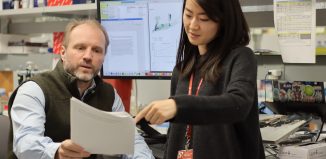CSHL’s Hammell wins Rita Allen Award for work on jumping genes
Molly Hammell had her head way beyond the clouds when she met Victor Ambros. At the time, she was a graduate student studying how models of dark matter and dark energy contribute to the distribution of galaxies seen in the sky. Through friends, she met Ambros and asked him about his work in molecular biology.
An amateur astronomer who took photographs of the night sky with a small telescope in his backyard, Ambros brought his family to public observations sessions Hammell ran at the Dartmouth College observatory. Speaking with Ambros helped give her the “biology bug,” she said.
Instead of looking at the remnants of dead stars like Cassiopeia A, which exploded around 1670, Hammell decided to focus her attention on events happening inside cells. Hammell handled the transition from astrophysics to biology incredibly well, said Ambros.
“In less than two years in my lab, [her] breadth and depth of biological knowledge had become comparable to that of any other postdoc at the same stage,” Ambros, the co-director of the RNA Therapeutics Institute at the University of Massachusetts Medical School, said.
She also shared her skill sets with the lab. Her lab meeting presentations were “exceptionally lucid and especially appreciated … as she could often make it almost effortless for the rest of us to understand what had been for us unfamiliar mathematical concepts,” Ambros said.
Now an assistant professor of genomics at Cold Spring Harbor Laboratory, Hammell studies transposons, or jumping genes. These bits of DNA can cut themselves out of one place in the genome and insert themselves into another spot. Another type of transposon makes an RNA copy of itself and then uses that copy to insert new DNA in another spot.
Transposons transcripts can become misregulated in neurodegenerative diseases, including amyotrophic lateral sclerosis, or Lou Gehrig’s disease, and frontotemporal lobar degeneration.
Her work with transposons has not only generated results, but has also distinguished her as a Rita Allen Scholar, an honor she received at the beginning of July. The award supports promising early career investigators and provides up to $110,000 annually for five years.
Hammell and her collaborators “have made one of the first connections between transposon activity and the function of a protein associated with neurodegenerative disease,” Ambros said.
“The possibility that transposon activation could contribute to the causes and/or progression of neurodegenerative disease is an extraordinarily important question.”
Hammell said she has looked for clues about the link between transposons and these diseases. It’s unclear yet whether the transposons are a causal factor in these diseases or whether they are a byproduct. Working with others at Cold Spring Harbor Laboratory, including Joshua Dubnau and Marja Timmermans, Hammell is hoping the team can gain a better understanding of the way transposons affect neurodegenerative diseases.
In one line of experiments, the researchers are looking to take animal models of these diseases and inhibit transposon activity. “If we can slow down or stop the symptoms in those models, that would be a fabulous clue,” she said.
Hammell is using computational analysis to differentiate between the effects of a protein called TDP-43 that is implicated in these diseases and the transposons themselves. Studies at Cold Spring Harbor Laboratory indicate that TDP-43 might normally keep transposons in check. If TDP-43, however, doesn’t work the way it should, these transposons can become more active, which may lead to diseases.
Some transposons, Hammell said, are closely related to retroviruses in the way they are copied in the cell. Drugs like AZT that is used as a treatment for AIDS might also be effective in controlling transposon activity in patients with ALS and other neurodegenerative diseases.
Hammell lives in lab-provided housing with her 10-year-old daughter Anna and her 4-year-old son Max in a converted firehouse on the shores of the harbor. The previous exit door for fire engines is now a huge glass window overlooking Cold Spring Harbor.
As for her work, Hammell appreciates the opportunity to contribute to research that may help people suffering with disease. Hammell’s grandmother succumbed to Alzheimer’s disease when she was a postdoctoral student. “If the work I do helps understand the progression of that disease,” she said, “that would make my family proud.”






